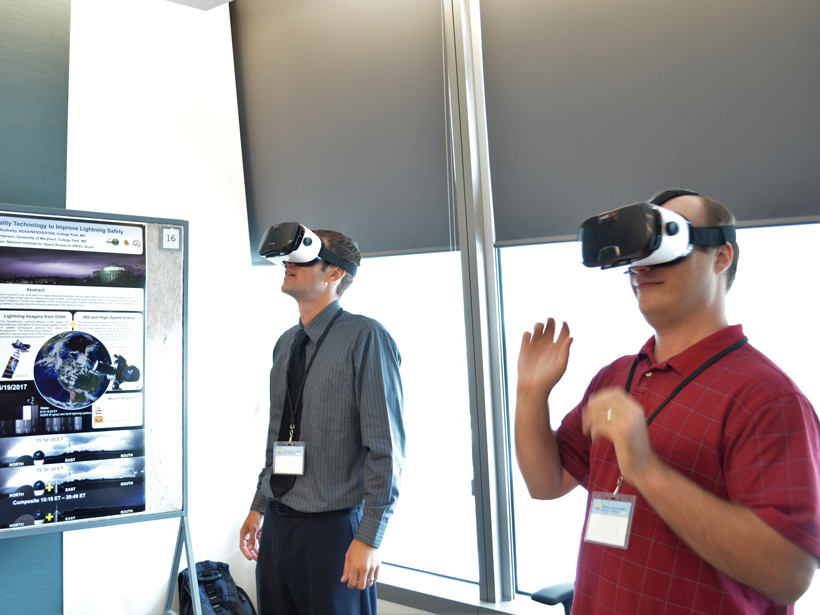One of the National Oceanic and Atmospheric Administration’s (NOAA) primary objectives is to share information about changes in weather, climate, oceans, and coasts. Effectively sharing this information requires emerging technologies that use new methods to collect data and convert them into knowledge. Emerging technologies is an area of special interest to managers who oversee NOAA’s observing systems, which account for roughly half of NOAA’s $5.7 billion annual budget.
The NOAA Observing Systems Council (NOSC) sponsors Emerging Technologies Workshops (ETWs) to spotlight technologies on the rise at NOAA. The second annual ETW, held in August 2017, included an expanded format that allowed presenters from industry and academia to discuss some of NOAA’s most urgent needs.
The most significant gaps in NOAA’s observation requirements were identified using a methodology that predicted the impact on NOAA’s mission if the gaps went unfulfilled.
Stephen Volz, NOAA’s assistant administrator and acting assistant secretary for environmental observation and prediction, used his keynote address to stress the workshop’s key role in managing, directing, advancing, and improving NOAA’s observing system portfolio and its ever widening range of information gathering services.
The workshop contained seven plenaries. Each plenary showcased as many as five new technologies and concluded with an expert panel (Table 1). NOAA’s Technology, Planning and Integration for Observation (TPIO) division had identified the most significant gaps in NOAA’s observation requirements, using a cutting-edge methodology that it developed to predict the impact on NOAA’s mission if the gaps went unfulfilled. Respondents to a special request for information (RFI) that NOAA distributed before the workshop were asked to propose new technologies that could fill these gaps, and these responses, in turn, determined the session topics.
| Table 1. The 2017 Emerging Technologies Workshop by the Numbers | ||
| Numbers | Examples and Details | |
| Number of participants | 260 | about two thirds affiliated with NOAA; about one third from industry, academia, and other governmental agencies |
| Subject matter experts on emerging technologies | 41 | about 75% affiliated with NOAA, about 20% from private industry and academia, and about 10% from agencies across the federal government |
| Technical posters created by participants that further detailed these new and emerging technologies | 38 | see below |
| Emerging technologies featured in short talks, 10–15 minutes each | 33 | conducting severe weather reconnaissance with unmanned aircraft; modeling ocean currents using a cloud-based sandbox; building 3-D wind models using mashed-up data from multiple satellites; improving satellite geolocation by leveraging smartphone-based GPS capabilities |
| Environmental information gaps outlined in NOAA’s ETW request for information, released on FedBizzOpps.gov | 10 | ocean-based information gaps, including global ocean current profiles, temperature profiles, and salinity profiles; and land/atmosphere-based information gaps, including bathymetry, hydrography, topography, elevation, and surface wind profiles |
| Environmental domains based on the location of the observing system platform, each featured in its own session | 4 | oceanic, atmospheric, terrestrial, and space |
| New session topic on data management and analytics | 1 | new for 2017 |
A major outcome of the workshop was the recommendation to improve engagement between NOAA and the private sector, academia, and other federal agencies. The workshop successfully engaged these sectors by providing a platform for NOAA to articulate its needs and allowing organizations to present relevant technologies. Presenters noted that industry can offer many resources to NOAA regarding innovation capacity, information technology bandwidth, and personnel that could expedite product creation and expand the breadth of products the agency makes available.
Participants suggested that NOAA do more to harvest mature data analysis techniques that can make better use of the “big data sets” that NOAA collects and creates.
Participants also suggested that NOAA do more to harvest mature data analysis techniques that can make better use of the “big data sets” that NOAA collects and creates. This effort would involve expanding the use of cloud computing to increase the agency’s analytic capabilities and the availability of NOAA data.
Detailed workshop information is available on NOAA’s ETW meeting dashboard. The ETW website contains the official NOAA workshop report and will contain information about the next workshop.
Nothing in this report is a U.S. government endorsement of any company or product. No financial or travel support was provided to private-sector entities to attend or present at the workshop. The RFI issued by NOAA stated that anything shared with NOAA in response to the RFI, or presented at the ETW, could be made publicly available.
We thank the TPIO employees involved in generating this report, including Meredith Wagner, Jeff de La Beaujardière, Brit Meredith, Jon Corsiglia, Daniel Gillespie, Alyssa Templeton, and TPIO director Martin Yapur.
—Justin C. Goldstein (email: [email protected]) and Anne J. Kennerley, Technology, Planning and Integration for Observation Division, NOAA, Silver Spring, Md.; also at Riverside Technology, Inc., Fort Collins, Colo.; and Adam Steckel, Technology, Planning and Integration for Observation Division, NOAA, Silver Spring, Md.
Citation:
Goldstein, J. C.,Kennerley, A. J., and Steckel, A. (2018), NOAA seeks emerging technologies to further its mission, Eos, 99, https://doi.org/10.1029/2018EO098135. Published on 16 May 2018.
Text © 2018. The authors. CC BY-NC-ND 3.0
Except where otherwise noted, images are subject to copyright. Any reuse without express permission from the copyright owner is prohibited.

